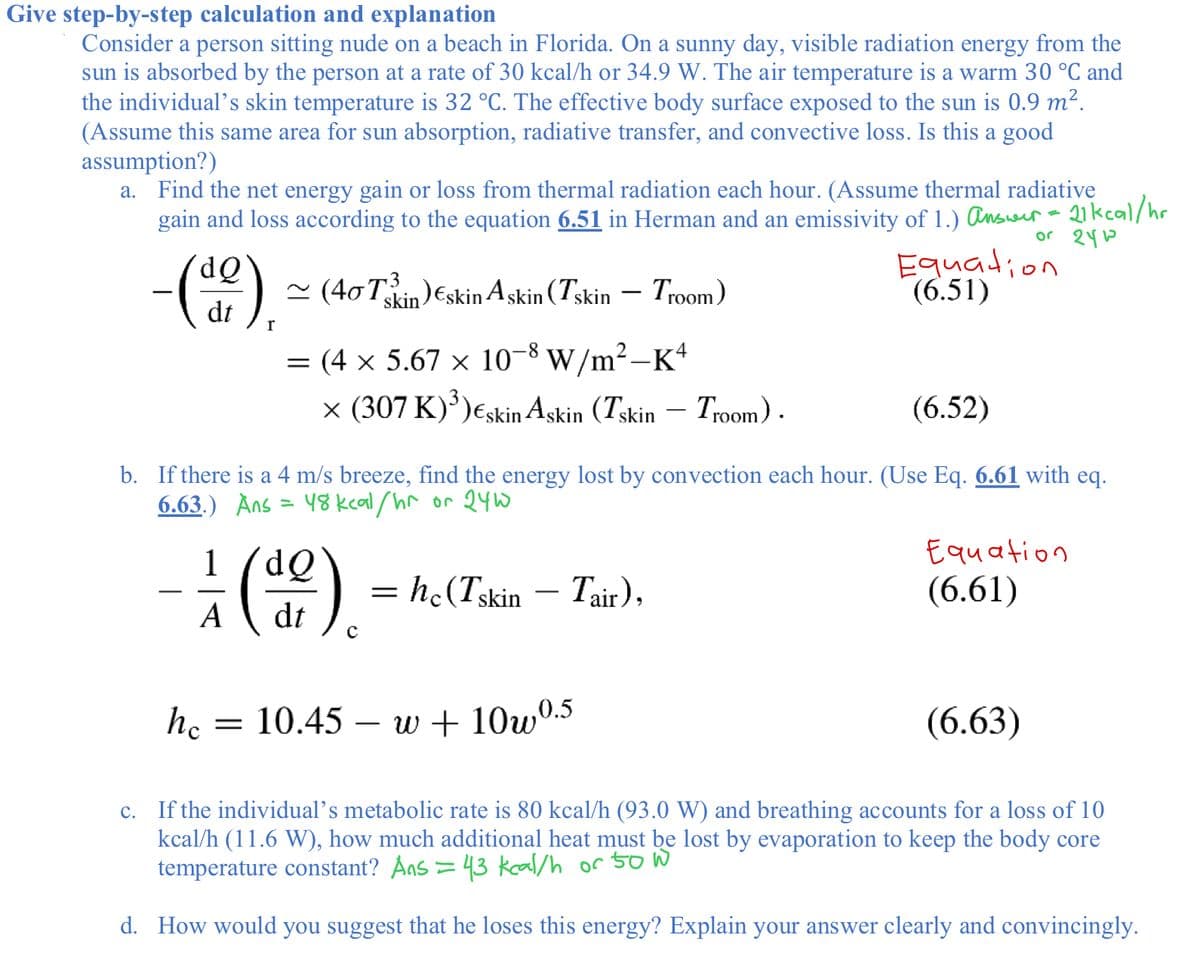Consider a person sitting nude on a beach in Florida. On a sunny day, visible radiation energy from the sun is absorbed by the person at a rate of 30 kcal/h or 34.9 W. The air temperature is a warm 30 °C and the individual's skin temperature is 32 °C. The effective body surface exposed to the sun is 0.9 m². (Assume this same area for sun absorption, radiative transfer, and convective loss. Is this a good assumption?) a. Find the net energy gain or loss from thermal radiation each hour. (Assume thermal radiative gain and loss according to the equation 6.51 in Herman and an emissivity of 1.) Anseera 21kcal/hr or 24 -(). Eguadion (6.51) - (40Tin)Eskin Askin (Tskin – Troom) dt = (4 x 5.67 × 10-8 w/m²–Kª x (307 K)')eskin Aşkin (Tskin – Troom). (6.52) b. If there is a 4 m/s breeze, find the energy lost by convection each hour. (Use Eq. 6.61 with eq. 6.63.) Àns = 48 kcal/hr or 24W 1 (dQ Equation = h.(Tskin – Tair), (6.61) - - A dt he 10.45 – w + 10w" ,0.5 (6.63) c. If the individual's metabolic rate is 80 kcal/h (93.0 W) and breathing accounts for a loss of 10 kcal/h (11.6 W), how much additional heat must be lost by evaporation to keep the body core temperature constant? Ans = 43 kal/h or sow
Consider a person sitting nude on a beach in Florida. On a sunny day, visible radiation energy from the sun is absorbed by the person at a rate of 30 kcal/h or 34.9 W. The air temperature is a warm 30 °C and the individual's skin temperature is 32 °C. The effective body surface exposed to the sun is 0.9 m². (Assume this same area for sun absorption, radiative transfer, and convective loss. Is this a good assumption?) a. Find the net energy gain or loss from thermal radiation each hour. (Assume thermal radiative gain and loss according to the equation 6.51 in Herman and an emissivity of 1.) Anseera 21kcal/hr or 24 -(). Eguadion (6.51) - (40Tin)Eskin Askin (Tskin – Troom) dt = (4 x 5.67 × 10-8 w/m²–Kª x (307 K)')eskin Aşkin (Tskin – Troom). (6.52) b. If there is a 4 m/s breeze, find the energy lost by convection each hour. (Use Eq. 6.61 with eq. 6.63.) Àns = 48 kcal/hr or 24W 1 (dQ Equation = h.(Tskin – Tair), (6.61) - - A dt he 10.45 – w + 10w" ,0.5 (6.63) c. If the individual's metabolic rate is 80 kcal/h (93.0 W) and breathing accounts for a loss of 10 kcal/h (11.6 W), how much additional heat must be lost by evaporation to keep the body core temperature constant? Ans = 43 kal/h or sow
Principles of Heat Transfer (Activate Learning with these NEW titles from Engineering!)
8th Edition
ISBN:9781305387102
Author:Kreith, Frank; Manglik, Raj M.
Publisher:Kreith, Frank; Manglik, Raj M.
Chapter11: Heat Transfer By Radiation
Section: Chapter Questions
Problem 11.65P
Related questions
Question
Heat loss

Transcribed Image Text:Give step-by-step calculation and explanation
Consider a person sitting nude on a beach in Florida. On a sunny day, visible radiation energy from the
sun is absorbed by the person at a rate of 30 kcal/h or 34.9 W. The air temperature is a warm 30 °C and
the individual’s skin temperature is 32 °C. The effective body surface exposed to the sun is 0.9 m².
(Assume this same area for sun absorption, radiative transfer, and convective loss. Is this a good
assumption?)
a. Find the net energy gain or loss from thermal radiation each hour. (Assume thermal radiative
gain and loss according to the equation 6.51 in Herman and an emissivity of 1.) Answeer a 21kcal/hr
or 2YD
-(4).
Eguadion
(6.51)
- (40 Tin)Eskin Askin (Tskin – Troom)
dt
= (4 x 5.67 x 10¬8 w/m²–K*
x (307 K)³)€skin Aşkin (Tskin – Troom) -
(6.52)
b. If there is a 4 m/s breeze, find the energy lost by convection each hour. (Use Eq. 6.61 with eq.
6.63.) Àns
48 kcal /hr or 24W
1
Equation
h.(Tskin – Tair),
(6.61)
A
dt
he
10.45 – w + 10w0.5
(6.63)
-
c. If the individual’s metabolic rate is 80 kcal/h (93.0 W) and breathing accounts for a loss of 10
kcal/h (11.6 W), how much additional heat must be lost by evaporation to keep the body core
temperature constant? Aas = 43 kcal/h or 50w
d. How would you suggest that he loses this energy? Explain your answer clearly and convincingly.
Expert Solution
This question has been solved!
Explore an expertly crafted, step-by-step solution for a thorough understanding of key concepts.
This is a popular solution!
Trending now
This is a popular solution!
Step by step
Solved in 3 steps with 3 images

Knowledge Booster
Learn more about
Need a deep-dive on the concept behind this application? Look no further. Learn more about this topic, mechanical-engineering and related others by exploring similar questions and additional content below.Recommended textbooks for you

Principles of Heat Transfer (Activate Learning wi…
Mechanical Engineering
ISBN:
9781305387102
Author:
Kreith, Frank; Manglik, Raj M.
Publisher:
Cengage Learning

Principles of Heat Transfer (Activate Learning wi…
Mechanical Engineering
ISBN:
9781305387102
Author:
Kreith, Frank; Manglik, Raj M.
Publisher:
Cengage Learning